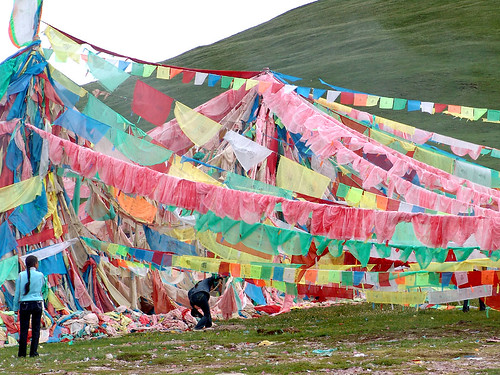Update: June 19, 2020
This post was originally published on Oct. 14, 2010. I have updated it now to take care of updated Google Earth imagery and also to replace the defunct images from Panoramio.
I have also included some information recently received through comments from reader Psycho Babble Junk.
____________________________________________
It is common sight in Tibet to see colourful streamers flying from poles, temple roofs, trees, bridges and house tops. Tibetan Buddhist call these streamers as Prayer Flags and believe that these are links connecting Almighty and man and the wind which causes the fluttering and swaying of the streamers, carries their prayers to Him for His blessings.
This post was originally published on Oct. 14, 2010. I have updated it now to take care of updated Google Earth imagery and also to replace the defunct images from Panoramio.
I have also included some information recently received through comments from reader Psycho Babble Junk.
____________________________________________
It is common sight in Tibet to see colourful streamers flying from poles, temple roofs, trees, bridges and house tops. Tibetan Buddhist call these streamers as Prayer Flags and believe that these are links connecting Almighty and man and the wind which causes the fluttering and swaying of the streamers, carries their prayers to Him for His blessings.
One of my reader who writes under the name of Psycho Babble Junk has informed
via his
comments dated June 18, 2020 that;
The streamers are called Sutra Streamers. Its a "flag" often made of cloth, silk or paper with Buddhist Scriptures written on them. They are seen as or represent a bond between God and human in Tibetan Culture. Different colors represent the five elements of the universe like red is flame or fire and yellow is earth. When the winds hit the streamers and they flap in the breeze the prayers are said to be carried higher and higher to the ears of the Gods. The poetry or sentiment behind the practice is moving and beautiful.
While browsing Google Earth, I came across a wide area in Tibet having several
hills/mounds swathed with huge streamers. Perhaps it is the largest collection
of colourful arrays of streamers at a single place.
These streamers are located near the small town of Machen in Golog (aka as Guoluo) Prefecture. The town derives its name from the Tibet's second highest and one of its most sacred peak known as Amnye Machen or Amne Machin Peak whose elevation is estimated to be 6,282 metres (20,610 ft). Not much information is available about such an huge collection of colourful arrays, however the town is en route to the 195 kilometre (~120-mile) circumambulation of the mountain, which Buddhist pilgrims make each year, and it is likely that these streamers are placed by pilgrims as part of their annual ritual.
Like spider's web the streamers are in constant
state of flux as can be seen from the satellite images captured from time to
time;
Google Maps imagery 2011 - the satellite view has changed from the 2010 view and coverage area has also increased.
Click on the image for enlarged view.
Google Maps imagery 2020 - the entire web of streamers has moved further east, perhaps to cater for increased land space for the city.

Click on the image for enlarged view
Image Source: Google Maps



Image copied from blog by joplus (in Japanese) (English Translation).
Photo by たびかめ氏 - Exact copyright status is not known, however permission for re-use is awaited.
Photo by たびかめ氏 - Exact copyright status is not known, however permission for re-use is awaited.

Image from Flickr is by rudenoon
View location in Google Maps



I couldn't find a date on this post so I have no idea how long ago it was written. 7 Years in Tibet was playing on a random cable channel today, which I of course watched for the hundredth time. I read up on Tibet's most recent troubles and trials. Then I too "Armchair Traveled" across parts of Tibet on Google Earth wondering what these streamers were I kept seeing. The streamers are called Sutra Streamers. Its a "flag" often made of cloth, silk or paper with Buddhist Scriptures written on them. They are seen as or represent a bond between God and human in Tibetan Culture. Different colors represent the five elements of the universe like red is flame or fire and yellow is earth. When the winds hit the streamers and they flap in the breeze the prayers are said to be carried higher and higher to the ears of the Gods. The poetry or sentiment behind the practice is moving and beautiful. I've barely touched on the subject and it goes so much more deeper than that. Unfortunately when I see these Photo Spheres on Google Earth I don't see the beauty any longer that was once there. Now you see tourists trampling over things, piles of discarded trash, strewn wrappers and debris and random junk. I saw some old tires and empty Tide bottles on one SMH.The practice has been commercialized as a photo op for tourists to get off a tour bus and snap a photo. Keep the camera pointed towards the sky and maybe you'll see something pretty. It definitely no longer remains at eye or ground level amongst tourists who have no idea of what once was truly a majestic site to see.
ReplyDeleteThank you Psycho Babble Junk for your comments. The post was made almost 10 years ago. (The date is now visible.)
ReplyDeleteBased on your comments I have updated the post and have also included part of your comments in the post.
It is a pity to see the damage caused by the tourism industry.